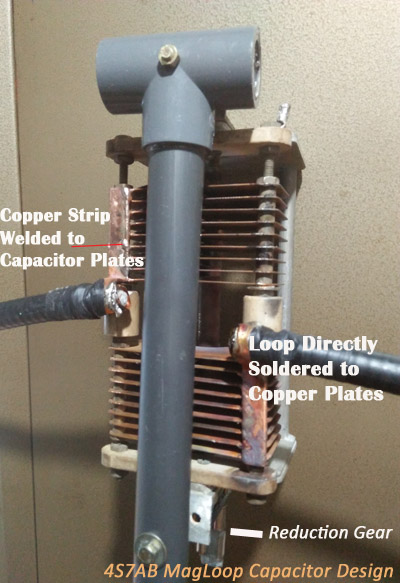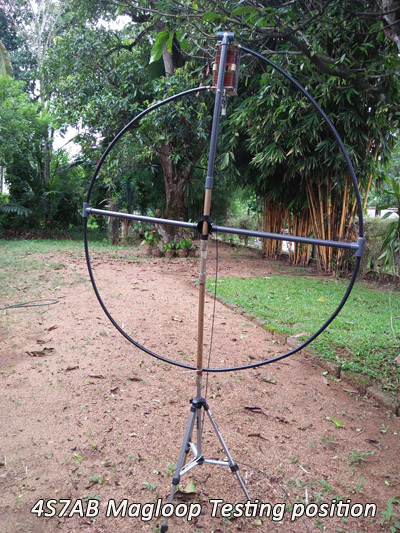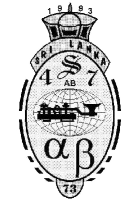The Magnetic Loop (30m to 15m)
Expectations and Realities
1000+ already viewed!
Article Summary
Unlimited Design ideas, Photos, Write-ups about this tiny little antenna all over the internet inspired me to try it out one day… But this “one day” never came partly because I had enough quads and yagis to cover each band from 40m and up.
RSSL field day/Family get together 2018 triggered a new desire when 4S7LF Leo gave a FB presentation about his mag loop and later offered me with a partly built Split-stater variable cap which was a much needed part in the Mag Loop design.
Article Highlights
- Design of Magloop Antenna
- Home-brewing the parallel plate CAP
- Feed Method and tuning for 50 Ohms
- The results and comparison with other antennas.
- Future Design Goals / Ideas

Kamal Edirisinghe
4S7AB / KA5MAL
Author June 2018
Having More than 35 years of experience in the Field of Amateur Radio, I have published many articles in prestigious international publications like, QST, CQ-DL, NCJ, Six-News etc.. Here in this web site, these write-ups are intended to give you knowledge about my designs and projects related to the hobby. The articles about foreign HAM activities are intended to share my experience.
- Full Solar Powered Radio Station
- SO2R and Multi-Multi Compatible
- Operate on All Bands/Modes/SATS
- DXCC #61,271
- IOTA AS-003, CQ-22, ITU-41
So the design and construction began in Apri 2018 without any “band-target” but utilizing all available components. My main goal was to see how it works and not to fill a gap in my antenna farm. There were no gaps to be filled
Design
There are 2 most critical components in the loop design. The copper loop and the variable cap. Without suitable components for these, you should not start building this antenna. If you do, surely will end up with disappointment. I had a 3m LDF4-50, Heliax 1/2″ cable. I did some calculations using the formulas given in the net, and that was OK on 20m and 17m with less than 50pf tuning cap. It was tune-able on lower bands with higher capacitance but that doesn’t mean it would “radiate” well.
The other most critical part is the variable capacitor. It MUST not have moving contacts through the RF current carrying path. Plates should be well spaced apart in order to handle Kilo-volts even with 10W of feed power. The connection between the cap plates to the copper tube should be ‘Solid’. In my case I have directly soldered them. It cannot get any better than that.
I used a reduction gear with a motor that had 6RPM marked on it with 12V. I was able to use 3V with a battery cell to get that rate even lower. That was OK to tune.
Feed method and tuning for 50 Ohms
Feed is simple and it’s a 1/4″ copper tube 1/5 of the size of the main loop as given my many builders. It’s easy to match the feedpoint to 1:1 SWR at the operating frequency by changing the placement position of the feed loop. It stays 1:1 for 30m, 20m and 17m bands. Slightly higher on 15m. But manageable.
The results and comparison with other antennas.
Here, I know it is not proper to compare an apple to a banana. But here my goal is clearly not to do a proof of concept for the Mag Loop but to see how it fits in my antenna system and what it is going to be doing in the coming years.
Initial results with the copper loop connected to the cap with normal soldering wire was disappointing. The bandwidth was somewhat wider (100Khz on 20m). But when the loop was directly soldered to the cap, the 2:1 bandwidth came to about 20Khz.
When I compared the Mag-Loop with a 4el yagi, the Mag loop doesn’t even come close. The S1 level weak CW signals I hear on the yagi are “not heard” on the Mag Loop. Only the “somewhat strong” signals are copied on the mag loop. But the Mag loop is obviously quieter than the yagi. That doesn’t mean that the Mag loop can dig weaker signals better. It means when both copy signals, mag loop listening is more pleasant to the ear specially on a CW pileup. With my 25+ years experience, I would assume that the Mag Loop cannot beat a properly put 1/2 wave dipole.
Where a Mag Loop can fit : In a situation where you cannot even put a proper dipole, a mag loop can be handy. It occupies very less space. Can be tripod mounted or kept inside the balcony. Can be rotated easily to peak the signals. Also for portable operations, this tiny little antenna can be useful.
In my opinion, Mag Loop is quite suitable for hams with a higher ham density in the near vicinity like in EU, NA or JA. But for 4S7 to get to a decent DX contact, we need to pass at-least 1000km. In this situation with low propagation on top of that, Mag Loop user will find it difficult to operate Dx on a consistent basis. Some of my European Dxer friends have also confirmed this idea.
Future Design Goals / Ideas
Due to the space restrictions on 80m and 160m, This antenna could be useful if properly built without any compromises. I may try a good design with a vacuum variable cap for Top bands in the future.





